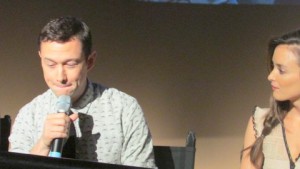A Conversation With Director Rosemary Rodriguez About Her New Film ‘Silver Skies’
by Susan Kouguell

“Silver Skies,” Rosemary’s second feature, chronicles a group of seniors whose lives turn upside down when their Los Angeles apartment complex threatens to be sold out from under them.

I had the pleasure of speaking with writer and director Rosemary Rodriguezin midtown Manhattan two days before her film “Silver Skies” will have its United States premiere at the Woodstock Film Festival on Saturday October 3.
Rosemary Rodriguez wrote and directed the feature, “Acts of Worship, “which premiered at the Sundance Film Festival, was nominated for two Independent Spirit Awards, including the John Cassavetes Award for Best Feature. Her episodic TV work includes “Empire,” “The Good Wife,” (where she is a regular director), “Manhattan,” “Rake,” “Elementary” and “Vegas.” She is currently directing the new Marvel series on Netflix, “Jessica Jones.”
“Silver Skies,” Rosemary’s second feature, chronicles a group of seniors whose lives turn upside down when their Los Angeles apartment complex threatens to be sold out from under them.
We began our conversation talking about the evolution of “Silver Skies.”
Rodriguez : It took about ten years. I ended up going to the MacDowell Colony with an outline for “Silver Skies” and wrote the script while I was there. Then, when I directed a “Law and Order” episode, I hit it off with (star) Dennis Farina and he loved the script. He helped to get the movie made. Fast forward almost two years later I called Dennis and told him we got the money. We picked the start date, and then he passed away two weeks later. I was devastated when he passed away. But then things fell in place. Fred Roos and Arthur Sarkissian came to the reading of the script, and they said, ‘let’s do this movie.’ The movie is dedicated to Dennis. He was my guardian angel.
Kouguell:
In “Silver Skies,” the theme of ageism is tackled straight on. The characters in this ensemble piece are threatened with the possible loss of their
homes and livelihood. You describe “Silver Skies” as very personal and inspired by your parents’ aging. The characters of Nick and Phil are inspired
by your father, who was a bookie in Boston, and the character, Eve, by your mother.
Rodriguez
: Valerie Perrine’s character always has flowers; that was my mother. I watched my parents get old when I was still young. I saw how their relationships
changed. You think logic would say life would get easier when you get older, but the emotional truth is that life still happens on its own terms. I think
seniors don’t have a voice in this world. These are people who want to have sex. They want to work. They want to spend money. Make money. Have money.
Kouguell:
You don’t shy away from thought-provoking issues, facing this generation, including the sexual assault of one female character and another main character’s
choice she made of personal survival that causes the death of her spouse.
Rodriguez
: My role model for directors is Robert Altman. His movies were a slice of life. The ironic thing about being a human being on this planet is that you have
no idea what is going to happen next. The movie is real life. You’re going on a roller coaster ride; there are parts you’re laughing because life is like
that, and then the rug gets pulled right out from under you.
The issues women go through, and with this female character with her husband abusing her, and feeling guilty over surviving, doing whatever she had to
survive, whatever way she needed to behave was maybe ‘not as a good girl’ would, and coming to terms with that. Sexual abuse to elders is real. Elder abuse
is real. I wanted to bring that issue in, as well as bring in that feminist message in there.
Kouguell:
In “Silver Skies,” the trepidation and excitement of newfound love is complicated by raw emotion as seen in one character’s
personal and financial insecurities with a recent widow.
: Love doesn’t stop people at a certain age, it doesn’t stop their desires. It doesn’t matter what age we are. To work with these wonderful actors and Alex
Rocco in particular — he was just like a teenage boy when doing his scenes with Valerie Perrine, saying: “I’m used to playing killers, I’m not used to
playing lovers.”
(Alex Rocco passed away July 18of this year.)
Rodriguez
: The recent memorial for Alex was on the racetrack: “Friends of Rocco” – it was the seventh race, it was dedicated to him. I loved him dearly. I miss him
dearly. It was intended as a celebration of this wonderful man. His character reminds me of my dad. As I told my dad when it became clear he had to retire,
I told him, “You always wanted to go out a winner.”
Kouguell:
The film stars Barbara Bain, George Hamilton, Jack McGee, Valerie Perrine, Mariette Hartley, Howard Hesseman, Jack Betts, and Alex Rocco. Did they have any
input into the script?
Rodriguez
: They definitely did. They stuck to the script a lot. I’m a big collaborator; I want to hear what people have to say. In the film George Hamilton’s
character is in the early stages of Alzheimer’s. Jack McGee’s brother, George Hamilton’s mother, and my dad, all had Alzehimer’s and we shared our
respective experiences to further develop George’s character. In a way it was a tribute for George to his mother, for Jack to his brother, and mine to my
father.
Kouguell:
You’ve earned great success as a director on “The Good Wife.” How has directing television influenced your work as a director on “Silver Skies”?
Rodriguez
: I can work efficiently and quickly, and in television that’s some of the skill set that gets developed. My instincts are very sharp. The idea out there is
that we’re less creative working in television, but the real truth is we’re under such pressure that we can make decisions quickly, and also go with your
heart and instincts. It’s very quick and very satisfying, and of course millions of people see your work in a shorter window of time and that is opposite
of a movie.
Kouguell:
Currently, you are the 4th Vice President of the Directors Guild of America. Although there is more media attention on the low percentage of women
directors getting work in the industry, the numbers are still not rising fast enough.
Rodriguez
: The DGA works very hard and we all work hard to address the issue of diversity. It’s been a problem for many years. My involvement in the DGA is
reflective of how much the DGA cares about women directors and minority directors, and wants to get us out there. It’s a benefit to the Guild. There’s a
lot of content there now and opportunity for diversity. I want to be meeting with you in a few years when this isn’t an issue any more; where there are not
“female directors” – that there are just great storytellers and that we don’t have to separate each other.
Kouguell:
Some final words about “Silver Skies”?
Rodriguez:
The way these actors enriched my life was unexpected and so profound. These are people with 50 and 60-year careers in a tough industry. These actors showed
up and put their hearts in these characters. They’re artists. They were there for the love for what they do. They just loved the characters. They had
beautiful chemistry together. We are part of each other’s lives. I never could give back to them what they gave to me.
READ MORE
 Director Robert Zemeckis at THE WALK New York Film Festival Press Screening
Director Robert Zemeckis at THE WALK New York Film Festival Press Screening




















